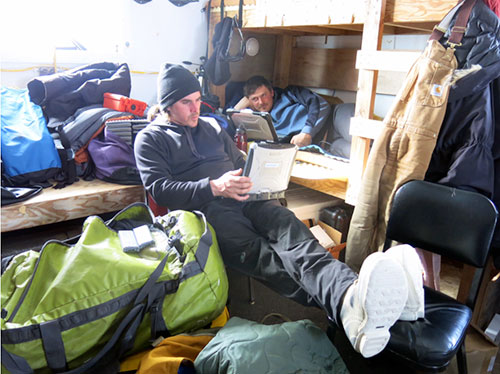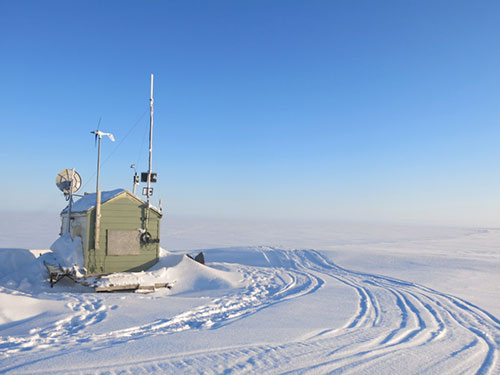
Teshekpuk Lake Observatory a special placeBy NED ROZELL April 26, 2014
Jones sees most coffee pots as half full, I have observed. The geographer/interested-in-everything scientist with whom I’ve been traveling for the past two weeks works at the USGS Alaska Science Center in Anchorage. Here on the northern shore of Teshekpuk Lake, the 35-year-old raised in Cincinnati is at home in a place that couldn’t be more different.
Ben Jones and Guido Grosse inside the Teshekpuk Lake Observatory, a 1963 research cabin Jones restored.
He first discovered the old Naval Arctic Research Lab structure on a map of useable shelters on the western North Slope he saw hanging on a wall in Barrow. A few years later, he visited the boarded-up cabin on a research trip to Teshekpuk Lake. He got excited thinking about fixing it up. Jones is now at the cabin for a few days with UAF’s Chris Arp and Guido Grosse of the Alfred Wegener Institute. The main objective of this three-week, 800-mile snowmachine traverse is to repeat measurements as part of an arctic-wide survey of changing lakes. Ben, Chris and Guido have led me about 400 miles by snowmachine so far; we are halfway on a round-trip between Toolik and Teshekpuk lakes. Chris’s instrumented lake buoys now frozen into ice, Guido’s shoved-auger permafrost cores from drained lakes and Ben’s all-of-the-above along with his tundra webcams have given the three buddies a good excuse to visit here twice each year, in winter and summer. This place, once known as Qaviarrat by Native hunters who harvested flightless geese nearby, is now called by some “Ben Jones Camp.” Outside this 12-by-20-foot frame structure is a smaller building, its exterior spiked with poles holding a wind turbine, weather station and a dish for satellite internet. Officials at the Bureau of Land Management, which owns the land, have written an official permit for Ben to clean up the site. He has done that and more to the only survivor of one dozen like structures that were built in 1963. That’s when Max Brewer, the director of Barrow’s Naval Arctic Research Laboratory, called for the construction of cabins to be cat-trained to remote sites. Brewer, who died in 2012, envisioned a string of research outposts at interesting areas across the North Slope. Scientists could fly into them with just sleeping bags and food and live in relative comfort. “Scientists often spend 90 percent of their efforts in such camps just taking care of existing,” Brewer wrote in a letter of appreciation to Ben a few years before his death at the age of 88. Brewer’s obituary hangs on the east wall of the cabin. Ben got help from many people in fixing up the 1963 cabin, including Craig George, Brian Person and Robert Suydam, who let him stay at a North Slope Borough Department of Wildlife cabin a few miles away. But he is its heartbeat, improving it a bit more every time he comes. One year, he installed a drip-oil stove he bought for $30 at an Anchorage garage sale and hauled northward. He replaced plexiglass windows with glass ones and installed a door where a tarp hung. He has made the Teshekpuk Lake Observatory a viable place to do science. It is painted green and features a sink with slop bucket, a drying rack that fits four pairs of bunny boots and propane cook stove. Except for the lack of neighbors, this could be a waterless rental outside Fairbanks. Ben’s enthusiasm about this warm shelter in the vast whiteness is what made me say yes when he asked me to join him on this journey a few months ago.
The electronics / storage cabin at the Teshekpuk Lake Observatory.
The Teshekpuk Lake Herd of caribou numbers in the thousands. The lack of towns or villages within 50 difficult miles also makes this a favorite place for geese and ducks to replace their flight feathers. Ben likes too that the lake hasn’t been studied much despite the space it takes up. This untouched setting is a nice opportunity for a scientist who is pretty good with tools and gadgets. He resurrected this place using varied skills from repairing carburetors on oil stoves to setting up motion-sensor webcams that freeze arctic foxes midstride a few steps away from the cabin. Ben first became enamored with the infinite feel of the tundra when working on a project in Barrow about 15 years ago. It is now as much a part of his life as the far north became for Max Brewer, who died in Anchorage but is buried in Barrow. Ben travels with Barrow Natives, has slept in their houses and knows how to pronounce the Inupiat names for the places elders point to on maps. At his reclamation cabin, a few years ago he proposed to his girlfriend, Kelly Harrell, who traveled here with him. She said yes. When at his office in Anchorage, Ben’s mind drifts north. He daydreams about what improvements he will make next, what old trash he will haul from the site. This year, he will visit Teshekpuk Lake Observatory in March, April, June, August, October and November. He says he wants to visit every month of the year to experience every mood of a place that explodes with life in summer and hums with quiet the rest of the year. He’s never been here in December, January and February, but he will get here in the dark season. When he leaves he’ll pencil another entry in the yellow logbook, like this one from his day of departure a few years ago. “Love it here. And always sad to leave.”
E-mail your news &
photos to editor@sitnews.us
|
||

